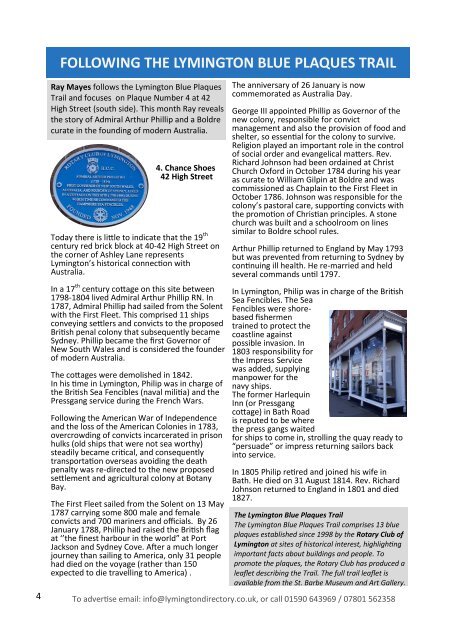Lymington Directory June july 19
Community magazine
Community magazine
Create successful ePaper yourself
Turn your PDF publications into a flip-book with our unique Google optimized e-Paper software.
FOLLOWING THE LYMINGTON BLUE PLAQUES TRAIL<br />
4<br />
Ray Mayes follows the <strong>Lymington</strong> Blue Plaques<br />
Trail and focuses on Plaque Number 4 at 42<br />
High Street (south side). This month Ray reveals<br />
the story of Admiral Arthur Phillip and a Boldre<br />
curate in the founding of modern Australia.<br />
4. Chance Shoes<br />
42 High Street<br />
Today there is little to indicate that the <strong>19</strong> th<br />
century red brick block at 40-42 High Street on<br />
the corner of Ashley Lane represents<br />
<strong>Lymington</strong>’s historical connection with<br />
Australia.<br />
In a 17 th century cottage on this site between<br />
1798-1804 lived Admiral Arthur Phillip RN. In<br />
1787, Admiral Phillip had sailed from the Solent<br />
with the First Fleet. This comprised 11 ships<br />
conveying settlers and convicts to the proposed<br />
British penal colony that subsequently became<br />
Sydney. Phillip became the first Governor of<br />
New South Wales and is considered the founder<br />
of modern Australia.<br />
The cottages were demolished in 1842.<br />
In his time in <strong>Lymington</strong>, Philip was in charge of<br />
the British Sea Fencibles (naval militia) and the<br />
Pressgang service during the French Wars.<br />
Following the American War of Independence<br />
and the loss of the American Colonies in 1783,<br />
overcrowding of convicts incarcerated in prison<br />
hulks (old ships that were not sea worthy)<br />
steadily became critical, and consequently<br />
transportation overseas avoiding the death<br />
penalty was re-directed to the new proposed<br />
settlement and agricultural colony at Botany<br />
Bay.<br />
The First Fleet sailed from the Solent on 13 May<br />
1787 carrying some 800 male and female<br />
convicts and 700 mariners and officials. By 26<br />
January 1788, Phillip had raised the British flag<br />
at ‘’the finest harbour in the world” at Port<br />
Jackson and Sydney Cove. After a much longer<br />
journey than sailing to America, only 31 people<br />
had died on the voyage (rather than 150<br />
expected to die travelling to America) .<br />
The anniversary of 26 January is now<br />
commemorated as Australia Day.<br />
George III appointed Phillip as Governor of the<br />
new colony, responsible for convict<br />
management and also the provision of food and<br />
shelter, so essential for the colony to survive.<br />
Religion played an important role in the control<br />
of social order and evangelical matters. Rev.<br />
Richard Johnson had been ordained at Christ<br />
Church Oxford in October 1784 during his year<br />
as curate to William Gilpin at Boldre and was<br />
commissioned as Chaplain to the First Fleet in<br />
October 1786. Johnson was responsible for the<br />
colony’s pastoral care, supporting convicts with<br />
the promotion of Christian principles. A stone<br />
church was built and a schoolroom on lines<br />
similar to Boldre school rules.<br />
Arthur Phillip returned to England by May 1793<br />
but was prevented from returning to Sydney by<br />
continuing ill health. He re-married and held<br />
several commands until 1797.<br />
In <strong>Lymington</strong>, Philip was in charge of the British<br />
Sea Fencibles. The Sea<br />
Fencibles were shorebased<br />
fishermen<br />
trained to protect the<br />
coastline against<br />
possible invasion. In<br />
1803 responsibility for<br />
the Impress Service<br />
was added, supplying<br />
manpower for the<br />
navy ships.<br />
The former Harlequin<br />
Inn (or Pressgang<br />
cottage) in Bath Road<br />
is reputed to be where<br />
the press gangs waited<br />
for ships to come in, strolling the quay ready to<br />
“persuade” or impress returning sailors back<br />
into service.<br />
In 1805 Philip retired and joined his wife in<br />
Bath. He died on 31 August 1814. Rev. Richard<br />
Johnson returned to England in 1801 and died<br />
1827.<br />
The <strong>Lymington</strong> Blue Plaques Trail<br />
The <strong>Lymington</strong> Blue Plaques Trail comprises 13 blue<br />
plaques established since <strong>19</strong>98 by the Rotary Club of<br />
<strong>Lymington</strong> at sites of historical interest, highlighting<br />
important facts about buildings and people. To<br />
promote the plaques, the Rotary Club has produced a<br />
leaflet describing the Trail. The full trail leaflet is<br />
available from the St. Barbe Museum and Art Gallery.<br />
To advertise email: info@lymingtondirectory.co.uk, or call 01590 643969 / 07801 562358


















